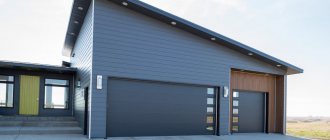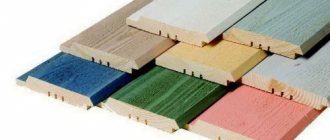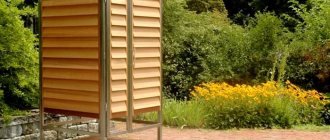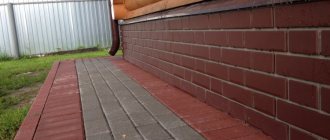What type of foundation should I choose for a private house?
Laying the foundation is the most important process in any construction, be it a skyscraper or a private house. Each owner must choose the type of construction for his future home, regardless of whether he will carry out the construction himself or whether professional workers will do it. In the second case, you will receive recommendations from the experts, but it won’t hurt to figure out for yourself what types of house foundations are used today. In this article we will analyze each design in detail, and also find out in what cases it is used.
Which foundation to choose for a private house
The type of foundation is determined at the design stage and depends on a combination of factors:
- engineering and geological conditions. This includes a soil sample and its examination, studying the depth at which groundwater lies, the heaving of the soil, and the terrain. The possibilities of connecting to communications are taken into account;
- collection of loads: what will be the total sum of all components of the structure;
- installation depth, and whether waterproofing and drainage will be necessary if there is a reservoir nearby;
- loads from neighboring buildings that cause soil deformation;
- the likelihood of accidents and breakthroughs, which can lead to soil subsidence;
- parameters of the house and its number of storeys;
- the presence of a basement, ground floor;
- soil freezing depth.
You also need to take into account in advance whether the house will be inhabited permanently or during certain months; the heating features depend on this.
Each foundation has its own advantages and disadvantages. Therefore, when choosing, you need to take into account all the nuances of the site, house and region so that your home is durable and reliable.
Types of foundation.
Types of foundations for a private house.
The diagram shows the main types of structures for a private house.
For structures made of wood, foam blocks or concrete, the following types of foundation are used:
It is impossible to single out the best or worst option, since the design of each type of foundation for private houses is different. Accordingly, the construction costs will also be different.
Advice: to choose a suitable foundation, you need to take into account the climate, base material and soil characteristics. In any case, consultation with professional builders will not be superfluous.
Now let’s look at each type for a wooden and concrete private house, as well as structures made of foam blocks.
What type of foundation should you ultimately choose?
The foundation is the foundation of the house being built, on which the entire load will rest. It is the quality of the laid foundation that determines the service life of the building. So before deciding which types of foundations are best to use in a particular case, it is necessary to take into account many factors. After all, each type of foundation has certain qualities that determine the advisability of using a certain type of foundation during construction.
Read about the following stages of construction:
Which is better to choose a foundation for the soil and type of house
Water supply for a private home
Well for water supply of a private house
Watch also the video about which foundation to choose
Read about the previous stages of construction:
How to choose the right plot of land for building a house?
Layout of land for building a house
Strip foundation.
Types of foundations for a private cottage.
Detailed diagram of strip foundations.
The structure consists of concrete strips buried in the ground, which take the load from all load-bearing elements of the building: columns and walls. Foundation slabs are used as support for concrete strips, serving as distribution pads. For a private wooden house, this is the simplest option, because you do not need to prepare the soil. The forces from the load-bearing elements are transferred to a large area of land.
Strip foundations can be divided into four types:
- intermittent - there are separate pieces of tape under the walls;
- rigid - equipped with an additional reinforcement belt, this type is used in large structures;
- monolithic - standard version, looking like a continuous tape;
- flexible - there is transverse-longitudinal reinforcement throughout the entire structure.
Device.
In practice, formwork is installed in the ground, reinforced with a reinforcement belt. Next, the concrete mixture is poured into it. This type for a wooden or concrete house is quite simple, but requires a lot of time due to lengthy preparatory work.
- the easiest way to make a foundation for a private house.
- the work can be done on your own.
- requires a lot of resources;
- long hardening time.
Types of foundations for a private cottage in Siberia.
The photo shows the completed strip foundation, which also includes a porch with steps.
This option is suitable for different designs.
Pile foundation.
This type, as one might guess from the name, is made from individual elements or pre-prepared groups. The piles are connected at the top by a grillage - usually for private houses a beam or a solid slab of reinforced concrete is used. Foundations made of piles for concrete, wooden dwellings, as well as for structures made of foam blocks, are used quite often. If large loads need to be transferred to the ground, and its characteristics are not enough for this, then a pile foundation is used. It is also advisable to use this type of construction for a wooden structure.
Types of foundations for a private house in Siberia.
The diagram shows a foundation on screw piles. As you can see, this design requires a minimal amount of materials.
Pile foundations can be divided into six types:
- driven - a standard option in which piles are driven into the ground;
- cluster - used under difficult construction conditions, several piles are installed in different places of the foundation;
- driven - used in large-scale buildings, piles are poured into special wells;
- solid - the piles are located as close to each other as possible, this type is also called a “pile field”;
- screw - metal piles are screwed into the ground;
- single - the method is used under comfortable conditions, piles are mounted only at the corners of the foundation.
If the house will stand on soft soil, then piles are an excellent solution for wooden and concrete structures, as well as for structures made of foam blocks. The piles will penetrate through weak soil and “rest” on solid ground. Piles for a private house are made from wood, concrete, metal, and also from combinations of these materials.
Types of foundations for a garage in a private cottage.
Sometimes a pile-strip foundation is chosen for a private house, which is shown in this diagram.
Screw and driven piles are sold as ready-made elements for construction, so they can be immediately screwed or driven into the ground. As for cast-in-place piles, they must be made at the site where the private house is being built. Installation is followed by leveling, then using a grillage the piles are connected into a solid structure. An important point: the width of the future wall of a wooden or concrete house should be equal to the width of the grillage.
- piles can be installed regardless of the type of terrain;
- Fairly easy installation.
- Suitable only for small buildings.
Types of foundation for a private house
There are the following types of foundations:
- pile;
- tape;
- columnar;
- slab;
- combined.
Each type has several options. Among them there are classic and new types of foundations - for example, the Swedish plate and the TISE foundation.
A strip foundation is understood as a strip-shaped foundation around the perimeter of the house. Types of foundations and their designs:
- monolithic. Reinforced tape is poured into the formwork at the construction site;
- prefabricated Made up of ready-made reinforced concrete blocks;
- prefabricated intermittent. Installed in separate sections under supporting structures;
- hard. Reinforced longitudinal belt;
- flexible. Reinforcement is longitudinal-transverse.
We advise you to study - All types of plywood - classification by grades, brands, sizes
In addition, the tapes differ in laying depth:
- shallow - usually within 50 cm;
- recessed - recessed below the frost line of the ground (depending on the geographical area).
Slab foundation is the so-called. floating slab, reinforced concrete, located on a bed of sand and crushed stone. Varieties:
- monolith. Filled immediately or layer by layer at the work site;
- prefabricated slab. Consists of separate reinforced concrete blocks. The blocks can be located close to each other or at some distance - this option allows you to save on construction. The presence of blocks under load-bearing structures is mandatory;
- Swedish stove. The design includes insulation and a “warm floor” system.
Pile types of foundations are piles immersed in the ground. The heads at the top are cut at the same level and connected into a single structure with a grillage.
Classification by material:
- wooden;
- concrete;
- metal.
By diving method:
- driven - from any material;
- screw (screw-in), metal only;
- bored – concrete. Wells are drilled, hollow pipes are placed in them, fittings are placed in the pipes and concrete is poured.
According to the installation diagram:
- single - at the corners of the house;
- cluster - in separate areas under supporting structures;
- pile field (solid) – close to each other throughout the entire area.
In addition to ordinary piles, which rest with their ends on solid layers, there are also hanging ones: they do not reach the solid layer, but are supported by the pressure of the adjacent soil on the side walls.
Grillage options:
- concrete beam around the perimeter of the house and under load-bearing internal walls. It can be monolithic or prefabricated from individual blocks;
- metal profile pipe;
- log or beam. Used for light wooden and frame buildings. For wooden ones, the function of a grillage can be performed by the lower crown;
- concrete plates.
The grillage can be low (at ground level) or high (at a distance from the ground surface).
A columnar foundation is the cheapest and easiest structure to construct (with the exception of monolithic pillars, they are more difficult and expensive to install). Usually elevated. Pillars can be made:
- made of monolithic concrete, with formwork;
- from concrete blocks;
- made of bricks;
- from metal and asbestos-cement pipes;
- from logs.
Combined foundations are usually used to strengthen the foundation on poor soils. The most famous:
- pile-tape. Screw piles are driven in; the function of a low grillage is performed by a reinforced concrete strip;
- TISE. A type of pile-tape with a raised grillage. The piles are bored with an expanded base, the grillage is “suspended” at some distance from the ground, and an inclined blind area extends from it.
Columnar foundation.
The design is similar to the pile version, only here the foundation is a pillar that is immersed in a special well. Also, the pole can be loaded without prior preparation. If pile and strip structures are connected using a grillage, then the pillars are attached to each other with reinforced concrete beams.
Do-it-yourself bathhouse foundation.
Pile columnar foundation.
This type is used for private wooden houses, as well as for buildings made of other light materials whose weight does not exceed 1000 kg/m3. If you are planning construction with your own hands, then it is best to make pillars for the foundation from brick or rubble concrete. When pouring a pillar, it is necessary to perform reinforcement every 35-45 centimeters. As an alternative, you can buy ready-made elements.
Tip: you can use a columnar foundation if the structure will stand on ground that is not subject to temperature deformation.
- fairly cheap base;
- you can do it yourself.
- not suitable for large houses.
Materials
Various materials are used to construct a strip foundation:
- Concrete.
- Brick.
- Rubble stone.
The most commonly used option is pouring concrete into formwork , where a reinforcing frame made of metal reinforcement has been installed. Concrete structures also include a prefabricated version, the elements of which are manufactured at the factory. This technology is easier and faster to install. But to install the foundation blocks, you will need a crane, the services of which will have to be paid for, which will increase the construction budget.
Brick strip foundations are rarely used today. But if it is chosen, then when purchasing, you need to pay attention to the technical characteristics of the brick itself, namely strength and frost resistance. As for rubble stone, it is recommended to use durable rocks to build a large stone house.
The difficulty of constructing a strip foundation made of stone lies in the fact that you will have to adjust the stones to each other both in size and in mating planes. This takes a lot of time, and experience in such construction will not hurt. Therefore, if there is no experience, then it is better to abandon this type in favor of a concrete structure.
Slab foundation.
The design is as follows: a recessed reinforced concrete slab is laid on the ground. The thickness of the main element can range from 30 to 100 centimeters. Reinforcement is a mandatory requirement for this type of structure. The slab foundation uses reinforcement with a diameter of 12 to 25 millimeters. The design is usually used on soft soils (embankments, quicksand, sand, etc.).
In private construction of a house made of concrete or foam blocks, a tiled foundation is rarely chosen, since complex calculations are required here. The main disadvantage of this design is the lack of a basement, because a solid slab cannot be disturbed. Usually this type is chosen in the most difficult situations. There is only one requirement for a solid slab - a level foundation. In other cases, pile or strip foundations are used.
Types of foundations for a private house.
This is what a finished slab foundation looks like for a dwelling made of foam blocks or concrete, as well as for a wooden private house.
Among other types, a monolithic slab has the highest load-bearing capacity and strength for houses made of wood, foam blocks or other materials. As for the disadvantages, there is only one - increased costs for materials. Either way, the design pays off in durability.
- has increased strength;
- Suitable for soft soils.
- high cost;
- requires a flat surface.
Compare all the designs, study their pros and cons, find out what kind of soil the future house made of concrete, foam blocks or wood will stand on. When you have this information, you will be able to build a reliable and comfortable home.
Basic types of foundations.
The following types of foundations can be used as the foundation for a residential building: • strip foundation:
a continuous sheet of reinforced concrete (for small buildings it can be made of brick) in the form of a closed contour, laid under all load-bearing walls;
• slab
(“floating”): is a monolithic reinforced concrete slab;
• columnar:
a system of massive concrete, brick, wooden pillars or supports with masonry, located at some distance from each other, with or without a grillage (frame connecting the pillars to each other);
Monolithic columnar foundation for a private house.
Pouring a columnar foundation.
• pile:
supports made of pipes connected by a grillage or without it; unlike the columnar one, it is not installed in holes, but is screwed or driven directly into dense soil.
Video description
What are the pros and cons of a pile screw foundation? Is it possible to make a high-quality foundation for little money? Watch in this video:
For bored and driven piles, a slab or strip grillage made of concrete is used for strapping; the screw supports are tied with a grillage made of timber or I-beams, or a channel.
This is what a pile foundation looks like Source skalice.ru
Frame house on a pile foundation Source kursremonta.ru
Columnar foundation
The construction of a columnar foundation involves the distribution of supports at a distance of 2-3 m from each other along the entire perimeter of the future house, the pillars are tied with a grillage. Columnar foundations, like strip foundations, are divided into prefabricated and monolithic. The latter is a concreted asbestos-cement pipe. The prefabricated one is built from FBS blocks or bricks.
The columnar foundation is tied with a grillage made of an I-beam or timber. The strapping is necessary to combine the poles into a single structure, which allows you to evenly distribute the load coming from the house and prevent them from tipping over.
Columnar foundations are used for the construction of frame houses and other light buildings up to two floors in height. The bearing capacity of a columnar foundation cannot withstand heavy brick and concrete houses. In addition, this type of foundation is not suitable for construction in heaving and moving soils.
Impact of soil heaving forces on a columnar foundation Source silastroy.com
Strip foundation.
Despite the fact that the construction of such a foundation requires a large amount of work and a considerable amount of concrete, due to their high strength, such foundations are most often used in construction. They are used both in the construction of stone or brick, and wooden and cinder block single- and multi-story buildings. To construct such a foundation, formwork with a reinforcing belt is prepared, into which the concrete mixture is poured. If there is weak soil, you can make a wider base (stepped foundation) or make it in the shape of a trapezoid
. where its wider part will serve as the sole.
Types of strip foundations for a private house.
Rectangular, stepped and trapezoidal strip foundations.
According to the method of construction, such foundations are divided into:
• monolithic:
a reinforcement frame is installed in the prepared formwork, then the formwork is filled with sand-concrete or rubble concrete mixture; Brick can also be used for their arrangement, however, the service life of such foundations is much lower;
• prefabricated:
assembled from ready-made concrete blocks, fastened together with cement mortar using reinforcement; but the strength of such a structure will be lower than that of monolithic ones, since at the joints the waterproofing will be significantly reduced, which will lead to its premature destruction, especially in swampy areas.
Types of foundations for a private house advantages.
Prefabricated strip foundation.
Based on their depth, strip foundations are divided into:
• shallow
. used for light buildings on slightly heaving soils (soils that are not very susceptible to frost heaving), laid to a depth of 50-70 cm;
Types of foundations for a garage in a private house.
Shallow strip foundation.
• deep-seated:
a rigid concrete frame is installed at a considerable depth (20-30 cm lower than the freezing level of the soil); used for buildings of significant weight.
Types of foundations for a private house.
Deeply buried strip foundation.
Important!
To avoid damage by groundwater,
a layer of waterproofing
.
In areas with low temperatures in winter, such a base can be additionally insulated
.
Types of foundations for a private house.
Waterproofing and insulation of the foundation.
When planning a basement, the walls of such a foundation also serve as the walls of the basement
.
As a rule, a sand and gravel cushion
. acting as drainage and serving as protection from groundwater. It is also capable of compensating for deformations. The absence of such a cushion is allowed only when constructing small buildings.
Advice
.
It is possible to reduce material costs in the construction of lightweight buildings by laying intermittent strip foundations
. They can be made from ready-made concrete blocks or poured directly on the construction site.
Design of a prefabricated intermittent foundation for a private house.
Intermittent strip foundation.
Slab foundation.
One of the most expensive designs. It can be either solid from monolithic concrete or in the form of a lattice slab made of crossed reinforced concrete beams with sealing of joints. Its minimum thickness is 20 cm (excluding stiffeners). Maximum thickness – 30 cm.
Method of arranging foundation formwork for a private house.
Lattice slab foundation.
Since such a foundation is not buried deep into the ground and is not subject to deformation during freezing and thawing of the soil, it is used mainly in difficult areas with mobile, loose (subsidence) or heaving soil
during the construction of small buildings (baths, garages, etc.).
If thoroughly insulated, such structures can also be used as a finished subfloor. The use of ready-made prefabricated slabs
is permissible only in the case of the construction of small buildings, since due to the heterogeneity of such a structure, its strength is reduced.
The slab foundation consists of several layers:
• geotextiles; • cushions made of sand and crushed stone; • insulation; • reinforcing belt; • the concrete slab itself; • waterproofing layer.
Types of foundations for a private house.
Slab foundation cut.
Slab as the foundation of a house
Slab foundation model
In the event that construction is planned on floating soils that are subject to strong and uneven compression, subsidence or heaving soils, it would be advisable to build a slab foundation. This type looks like a monolithic or lattice slab assembled from reinforced concrete beams with sealed joints. This type of foundation is built over the entire area of the building, and not just under the load-bearing walls. By the way, it is advisable to lay a “floating” foundation if construction is planned in an area where the groundwater level is close to the ground surface (less than one meter). The only disadvantage of this type of foundation is its high cost.
Reliable but high cost
Columnar foundation.
This is one of the low-cost and least labor-intensive ways to build a foundation for houses with light wooden or frame walls. Can be used for the construction of buildings on heaving soils
under conditions of laying the foundation just below the soil freezing depth.
In small buildings, it is possible to use shallow
(half the standard depth) or
non-buried
(40-50 cm) columnar structures.
Such structures are installed every 3-6 m, as well as in the corners of the building and at the junction or intersection of load-bearing walls on a sand “cushion”. Can be either monolithic
and be erected directly at the construction site, or
prefabricated
(manufactured in factories).
Types of foundations for a private house.
Monolithic reinforced concrete columnar foundation.
The cross-section of the pillars depends on the material of manufacture. Thus, when using concrete, their minimum cross-section is 400 mm, in stone structures - 600 mm, and when laying bricks - 380 mm.
Types of foundations for a private house.
Brick columnar foundation.
Types of piles include prefabricated structures of the so-called “ glass type”
" having two or more sections. In this case, the first link is driven half the length of the pile. The second part is inserted into a tubular glass. However, such structures are used only for the construction of industrial facilities and are not used in private construction.
The main disadvantages of columnar foundations include:
• impossibility of use on moving soils due to the tendency to tip over; This drawback can be partially eliminated by installing a grillage, using anchor foundation blocks or foundations with an expanded base;
Pouring a grillage for a private house.
Arrangement of a grillage for a columnar foundation.
Anchor columnar foundation for a private house.
• restrictions during construction on weak-bearing subsidence, water-saturated or peat soils; • complexity of the arrangement of basement premises (basements, underground garages, etc.).
Pile foundation.
A similar foundation is used for the construction of buildings on water-saturated, swampy or loose soils and soils subject to severe winter heaving, when it is necessary to deepen the foundation to a very great depth.
Types of foundation piles include:
• driven piles:
reinforced concrete rods with a square cross-section and a pointed end; they are immersed into the ground using special installations using the impact method;
Types of foundations for a private house.
Driven reinforced concrete piles.
• pipe concrete:
a hollow steel pipe equipped with a cone-shaped tip;
after installation, concrete solution is poured into the pipe; driving is carried out using special pneumatic machines; rarely used in private construction; Types of foundations for a private house.
Pouring pipe concrete piles.
• bored:
a reinforcement frame is first inserted into a prepared small well, and then cement mortar is poured into the prepared hole;
Drilling and reinforcing the foundation for a private house.
Preparing holes and pouring bored piles.
• screw:
They are hollow metal rods, at one end of which there are blades, with which they are “screwed” into the ground manually or using special equipment.
Choosing the appropriate type of foundation for a private house.
Foundations for houses can be very different. They are made from various materials and using various technologies. The choice is made separately for each specific case. It is impossible to clearly say which foundation is better. Even when building identical houses in different places, the type of support and the costs for it can vary dramatically.
- bearing capacity of soils on the site;
- soil moisture and groundwater level;
- terrain;
- the need for a basement;
- number of storeys of the building and the mass of its structures.
All these factors need to be taken into account simultaneously. It is difficult for a non-professional to accurately select what kind of foundation is needed for construction. If possible, it is better to contact an experienced designer. At the same time, he needs to provide information about the soils on the site and the design features of the structure.
Types of foundations for a private house.
Extracting a pit is the easiest and cheapest way to find out the type of soil and the depth of groundwater.
Before choosing the type of foundation, geological studies must be carried out. To build a house in the private sector, you don’t have to order an expensive procedure. It will be enough to roughly determine the type of soil and its depth. This work can be done in two ways:
Types of foundations for a private house
Each type of foundation differs in construction technology, characteristics, and conditions of use. For residential construction, the following types of foundations for a private house are usually used:
- pile;
- tape;
- slab;
- columnar.
Construction of different types of strip foundations on different soils Source shkolaremonta.info
See also: Catalog of companies that specialize in foundation repair and design
Online foundation calculator
To find out the approximate cost of various types of foundations, use the following calculator:
Strip foundation: what is its difference
Looking at the photo of the foundation below, it immediately becomes clear why it received such a name. The structure consists of strips dug into the ground; they take on the entire load of the load-bearing elements of the house.
The depth of the strip foundation is determined depending on the materials from which it is built. The design of a strip foundation for a private house is slightly different depending on the type of strip itself. There are two main types of strip foundations: monolithic and prefabricated. The first design option is erected immediately on the site, the second is assembled from reinforced concrete blocks. They are produced in factories, then brought to the construction site and, using specialized equipment, a prefabricated strip foundation is erected.
Strip foundation Source journal.n1.ru
A monolithic strip foundation is a reinforced concrete structure that is superior to the prefabricated type in terms of reliability and durability, since it is more resistant to deforming loads and is practically not subject to erosion by groundwater.
A prefabricated type of strip foundation is built not only from blocks, but also from rubble stone - rubble concrete (consists of concrete and boulders). Also a prefabricated type is a brick foundation; it is used for the construction of houses of no more than five floors.
Strip foundations are classified into two types according to their depth: shallow and deep structures. The base of shallow strip foundations is placed above the freezing level of the soil - at a distance of 30–80 cm from its surface. Deep foundations are deepened by 1.5–2 m, that is, the base is located below the freezing line of the ground.
Shallow strip foundation Source doka-metal.ru
Shallow strip foundations are suitable for the construction of houses of no more than two floors, provided that the soil at the site of construction is not prone to heaving. But deep foundations can be used in soils prone to thermal expansion.
The main advantage of strip foundations is the relatively low construction costs, with the exception of prefabricated structures made from foundation blocks, since their cost is quite impressive.
Strip foundation made of blocks Source t-spectr.ru
Types of foundations.
To answer the question of what types of foundations there are, we need to consider several classifications. For the construction of a building, types of foundations are distinguished by design and manufacturing method, as well as by material.
The choice of foundation, depending on the material, is proposed to be made from three options:
The first option is currently practically not used. Wooden piles were widely used in the past to construct buildings in marshy areas. But the disadvantage of wood is its high susceptibility to rotting and low strength. In modern conditions, it is not worth considering these types of foundations for a private house.
Another option for construction is metal. It has a limited range of applications. Only a certain type of foundation for wooden houses and frame buildings is made from it - pile-screw.
Pile foundation for a private house.
A pile-screw foundation is suitable for light wooden houses.
Reinforced concrete types of foundations for houses are the most widespread. This is due to the fact that concrete performs very well when working under compression. These are the loads that occur in the underground part of the building. There are exceptions, but in this case metal fittings are included in the work. Due to the combined action of concrete and reinforcement, reinforced concrete varieties are highly reliable and durable.
When using a reinforced concrete option, the question almost always arises: which foundation to choose, prefabricated or monolithic?
Prefabricated technology involves the use of ready-made factory-made elements. These types of concrete foundations can be built quickly; there is no need to wait for the material to harden. But these options are more intended for mass construction. They allow work to be carried out on an industrial scale in a short time, but require special heavy-duty and lifting equipment. It will be difficult and expensive to make such a foundation for a house yourself.
Types of foundations for a private house.
To install a prefabricated foundation, a crane is required.
An excellent option for private construction would be monolithic types of foundations and their various variations. Manufacturing requires virtually no special equipment. If desired, all work can be done manually. But still, to improve the quality of work and reduce the time it takes to complete it, it is recommended to order ready-made concrete at the plant and have it delivered using special mixers. In addition to the mixer, it is worth ordering a concrete pump. This technique allows you to quickly and effortlessly distribute the mixture into the formwork.
Types of foundations for a private house.
Monolithic foundation is one of the most popular solutions in private housing construction.
The disadvantage of monolithic technology for manufacturing foundations will be an increase in construction time. A stone made using this type gains strength on average within 4 weeks. During this time, it is prohibited to build walls on the supporting part.
In addition to differences in material and technology, it is worth highlighting the classification according to design features. Before choosing a foundation, you need to consider four main types. There are also several modifications within each group.
The following types are used for the construction of buildings:
Strip foundation.
If you answer the question, what kind of foundation is needed for a building with a basement? then the answer will be unequivocal - tape. This is the best and practically the only option. You can also use a slab base for these purposes, but tape will have to be used in this case as well.
What are strip foundations made of? It can be made from monolithic or prefabricated reinforced concrete. The device assumes the presence of three types of tapes depending on the depth of installation:
- Recessed. These types of house foundations are used when a basement is needed, as well as for the construction of massive buildings. The laying depth is determined depending on the height of the basement and the depth of soil freezing. The last characteristic is found separately for each region. During self-construction, you can use special maps and tables to find the mark.
- Shallow. This tape is buried approximately 70-100 mm into the ground. They are used for massive buildings without a basement on fairly good soils. It is also relevant when the groundwater level is located at a distance of more than 1.5 m from the surface. When supporting above the freezing mark, enhanced waterproofing and insulation must be provided. Read more about shallow tapes.
- Not buried. Used only for small buildings on solid, non-heaving foundations. Does not have high load-bearing capacity.
Non-recessed type.
You will also have to choose a strip foundation based on the type of section. It can be rectangular or T-shaped. The second option assumes the presence of a widening at the bottom in the form of a pillow and has higher stability and load-bearing capacity. It is used for buildings made of brick or concrete. When producing tape using prefabricated technology, special FL foundation pads are used to ensure widening; their production is carried out in a factory environment.
Slab foundation.
A slab is a good option for unstable soils. Just like the tape, this type can be recessed, shallow and non-recessed. The first option is used quite rarely due to its high cost.
Monolithic slab foundation diagram for a private house.
If we compare foundations, the slab has the greatest load-bearing capacity with approximately the same labor costs. In terms of load-bearing capacity on weak or marshy soils, only some types of piles can be compared. But they will cost much more and require a lot of effort and special equipment.
Most often, when constructing private houses, a non-buried slab is used. You can also consider an insulated Swedish stove. It will be an excellent solution for heaving soils in the northern regions.
Even a non-professional can make a slab. In private construction, the thickness of the structure is usually 200-300 mm. Such a foundation can support a two-story brick house. Reinforcement is performed with meshes in two rows. If the slab thickness is 150mm or less, then one row of reinforcement must be laid. Advice: it is recommended to use concrete grades B20-B25 for pouring. This is due to the fact that the slab foundation, in addition to compressive loads, perceives bending forces, which concrete does not handle very well. To avoid the appearance of cracks, you need to take care of high-quality reinforcement and durable concrete.
The plate is used in the following cases:
- construction of a brick or concrete house without a basement on swampy or unstable soils;
- construction of buildings at a high groundwater level (at a distance of at least 50 cm from the ground surface).
Slab foundations are also used in the construction of small building forms, which must stand on separate foundations to prevent uneven shrinkage. These forms include:
Pile foundation.
Piles are the only reasonable option when building on soils with groundwater levels higher than 50 cm from the surface of the earth. They also allow you to build a house on an unstable foundation and with strong differences in elevation on the site without significant effort.
In this case, it is not possible to provide a basement. The base is covered with finishing materials, leaving ventilation gaps and openings for free air movement under the house.
A grillage is installed along the edge of the piles. It can be made of wood, reinforced concrete or metal. The choice of material is made depending on the material of the walls and the piles themselves. For example, when building a wooden house, it is reasonable to use wood frames, and when constructing reinforced concrete piles, it is wise to use concrete.
Piles are classified according to material, manufacturing method and driving method. I can make it from metal or reinforced concrete, either in a factory or on a construction site. There are four most common types of piles:
- Driven from reinforced concrete. Not common in the private sector. Initially intended for use in mass construction and require special expensive equipment.
Types of foundations for a private house.
Driven piles are installed with a special pile driving machine.
- Bored. They are made of reinforced concrete directly on site using monolithic technology. They are not recommended for use at high water levels in the ground, since they require water reduction during construction work. This is a costly undertaking. Read more about bored foundations.
Comparison of screw piles and bored pile foundations. Bored piles are often combined with a monolithic grillage. - Screw. They are made of metal. Such elements are a pipe with a screw welded at the end. Due to this screw, the pile itself digs a hole during installation, which avoids the need to excavate the soil. Screw piles do not have high load-bearing capacity. They are used mainly in private construction as supports for frame or wooden houses. Can be used for one-story buildings made of lightweight concrete. The most common element diameter is 108 mm. Read more about installing a pile-screw foundation.
Types of foundations for a private house. There are many ways to tie screw piles. - TISE. Piles of this type are made in much the same way as bored piles. But this option has a significant difference - widening at the bottom. It is made using a special drill, which at a certain mark can throw off the knives that perform the widening. The solution is perfect for working on heaving soils, since the design prevents the house from being pulled out of the ground.
Construction of pile foundations for a private house.
Due to the larger cross-section, the TISE foundation has a greater load-bearing capacity.
Columnar foundation.
This option has the lowest load-bearing capacity of all presented. The approval does not affect special glass-type pillars, which are used as a base for columns in the construction of public and industrial facilities.
Construction of a columnar foundation for a private house.
A columnar foundation is very simple to manufacture, but has a low load-bearing capacity.
Most often, poles are used in the construction of small outbuildings on solid soils. In this case, they are made shallow or shallow. They can be made from ready-made elements (bricks, blocks) or from a monolith. Read more about columnar foundations.
Before choosing a foundation for a house, you need to carefully study all the necessary information. An irresponsible attitude can lead to cost overruns, building distortions during operation, or other troubles.
Recommendation: A good large review article, from it you can learn about the different types of foundations for building a private house. The abundance of information can lead you astray and you will choose the wrong type of foundation for your home. As a result, you will lose a lot of money and time. Be extremely careful in your choice.
Main types of foundations for a private house
Based on the design features, foundations are:
- tape;
- slab;
- pile;
- columnar.
These types of foundations are common in private low-rise housing construction.
Strip foundations
The most common types of foundations for a private house, at least in the territory of the former USSR. It is made of reinforced concrete and is a monolithic strip of constant cross-section, laid either under all the main walls of the structure, or under individual supports.
Strip foundation
Strip foundations are characterized by high labor and material intensity, but low manufacturability. The advantages include reliability and strength with proper reinforcement and compliance with all the nuances of construction (including control of the grade of concrete and maintaining the full “maturation” period). Depending on the depth of laying, there are two types:
- shallow;
- buried.
Shallow strip foundation
It is laid under light structures, wooden or frame houses on slightly heaving soils or after measures to reduce soil heaving. The advantages of shallow foundations are their shallow laying depth (within half a meter), which reduces excavation work and overall construction costs. The disadvantage is the complex calculation of the foundation, additional measures against soil heaving.
Recessed strip foundation
It is a tape laid below the standard freezing depth of the soil. Suitable for heavy brick houses or PGS houses with reinforced concrete floors. The disadvantage of this type of foundation is its massiveness, high cost, labor intensity and general archaism.
Slab foundations
The slab foundation for a private house is a monolithic or lattice reinforced concrete slab, which is located under the entire building area of the future structure. The advantage is its versatility, which then allows the construction of buildings from both brick and timber. The spatial rigidity that such foundations have allows construction on the most difficult soils (with high groundwater levels, highly heaving and floating soils). The disadvantages are engineering complexity, high cost, and high material consumption.
Reinforced concrete slab
Slab foundations include such types of house foundations as USHP (insulated Swedish slab) and UFP (insulated Finnish slab).
Pile foundations
The final form consists of rows of pointed piles. Basically they differ not so much in the material and depth of laying, but in the method of construction. Pile foundations for private housing construction are:
- screw;
- printed;
- drilling
A pile foundation is an ideal option for large-sized lightweight buildings. Allows you to build on unstable, floating soils (quicksands). In this case, the piles are driven or screwed into solid layers of soil that have a high bearing capacity. The load from the entire structure is transferred to these layers. The foundation itself is a so-called pile field, the distance between the piles of which is calculated based on the bearing capacity of the soil and the area of the base of the pile.
Screw piles
Advantages: cost-effectiveness, speed of construction, possibility of construction on difficult terrain. Disadvantages: low load-bearing capacity, which allows the construction of only light buildings; as well as technology, which almost always requires the use of special equipment.
Columnar, columnar-grillage foundations
The cheapest type of foundation for a private house. The pillars are installed at all corners of the building, under load-bearing walls and partitions, as well as under wooden floor beams that have long runs. These types of foundations are especially effective on heaving and heavily frozen soils, when the construction of a buried foundation is irrational due to the large depth of freezing.
The disadvantage of a columnar foundation is its instability under lateral heaving forces, which can lead to the column overturning. Therefore, to resist lateral shear, all pillars of such a foundation are connected at the top by a monolithic reinforced concrete beam (grillage).
The advantages of columnar and columnar-grillage foundations are their low cost and efficiency.











